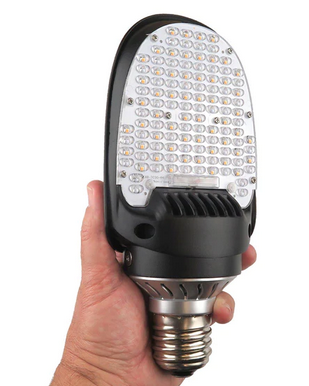Why is electric consumption continuing to go up? Sure, more people are getting access to electricity (there is still over one billion people that don’t have it) but there is also technology that reduces electric consumption. For example, I covered the use of induction cooking in a recent article. Here is another example of something that can make a difference.
The photo is of what is called “Warm White LED 3300 Lumen E39 Base Flat Corn Light Bulb”. Let me translate. It is a bulb designed to replace 175 watt metal halide bulbs used in streetlights, parking lot lights and such. This bulb consumes 27 watts and retails for $50. That’s an amazing saving in energy usage.
I just walked out to the edge of my deck and counted three streetlights in the block I live on on a residential street in Guatemala City. If we assume street lights are on 12 hours per day (sure, it varies between summer and winter but that is a good average) the energy saving for just the block I live on would amount to (175 – 27) * 3 * 12 * 365 watts per year. That’s 354 kWh for this one block. Changing all the street light bulbs in Guatemala City or New York or … could make a huge difference in electricity usage.
To help see a bigger picture, let’s use Los Angeles California as a model. There are about 6500 miles of city streets in LA. Blocks vary in size but lets pick 250 feet. A mile is 5280 feet so that would mean about 140,000 blocks. If there are three streetlights per block there like here we are talking 420,000 streetlights. The potential saving by switching to these bulbs is almost 50 megawatt hours of energy each year just for streetlights — it is not including lighting on parking lots, freeways and such.
While governments are telling us to turn off our TV when we are not watching it (and today’s TV uses much less energy than older ones) maybe we should be telling governments to change the streetlights.



